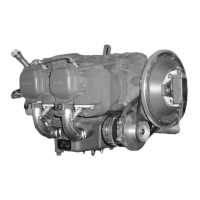LYCOMING OPERATOR’S MANUAL SECTION 3
O-320 SERIES OPERATING INSTRUCTIONS
(2) Best Economy Cruise (approximately 75% power and below) – Operate at peak
EGT, or if desired, drop 50°F on rich side of peak EGT.
2. LEANING TO FLOWMETER.
Lean to applicable fuel-flow tables or lean to indicator marked for correct fuel-flow for
each power setting.
3. LEANING WITH MANUAL MIXTURE CONTROL (Economy Cruise, 75% power or less,
without flowmeter or EGT gage).
a. Slowly move mixture control from “Full Rich” position toward lean position.
b. Continue leaning until engine roughness is noted.
c. Enrich until engine runs smoothly and power is regained.
As shown in Figure 3-1, if engine speed and throttle setting are kept constant at normal cruise conditions,
the effect of leaning on engine power and engine temperatures will be as shown. Power drops rapidly when
the engine is leaned beyond peak exhaust gas temperature; also, best power is attained on the rich side of
peak exhaust gas temperature.
8. USE OF CARBURETOR HEAT CONTROL. Under certain moist atmospheric conditions when the
relative humidity is more than 50% and at temperature of 20° to 90°, it is possible for ice to form in the
induction system, even in summer weather. This is due to the high air velocity through the carburetor
venturi and the absorption of heat from this air by vaporization of the fuel. The temperature in the mixture
chamber may drop as much as 70°F below the temperature of the incoming air. If this air contains a large
amount of moisture, the cooling process can cause precipitation in the form of ice. Ice formation generally
begins in the vicinity of the butterfly and may build up to such an extent that a drop in power output could
result. A loss of power is reflected by a drop in manifold pressure in installations equipped with constant
speed propellers and a drop in manifold pressure and RPM in installations equipped with fixed pitch
propellers. If not corrected, this condition may cause complete engine stoppage.
a. To avoid this, all installations are equipped with a system for preheating the incoming air supply to
the carburetor. In this way sufficient heat is added to replace the heat loss of vaporization of fuel,
preventing the mixture chamber temperature from dropping to the freezing point of water. This air
preheater is essentially a tube or jacket through which the exhaust pipe from one or more cylinders is
passed, and the air flowing over these surfaces is raised to the required temperature before entering the
carburetor. Consistently high temperatures can cause a loss in power and a decided variation of
mixture. The following outline is the proper method of utilizing the carburetor heat control.
(1) Ground Operation – Use of the carburetor air heat on the ground should be held to a minimum.
On some installations the air does not pass through the air filter, and dirt and foreign substances
can be taken into the engine with the resultant cylinder and piston ring wear. In dirt and dust free
areas carburetor air heat should be used on the ground to make certain it is functioning properly, or
when carburetor icing conditions require it.
3-5

